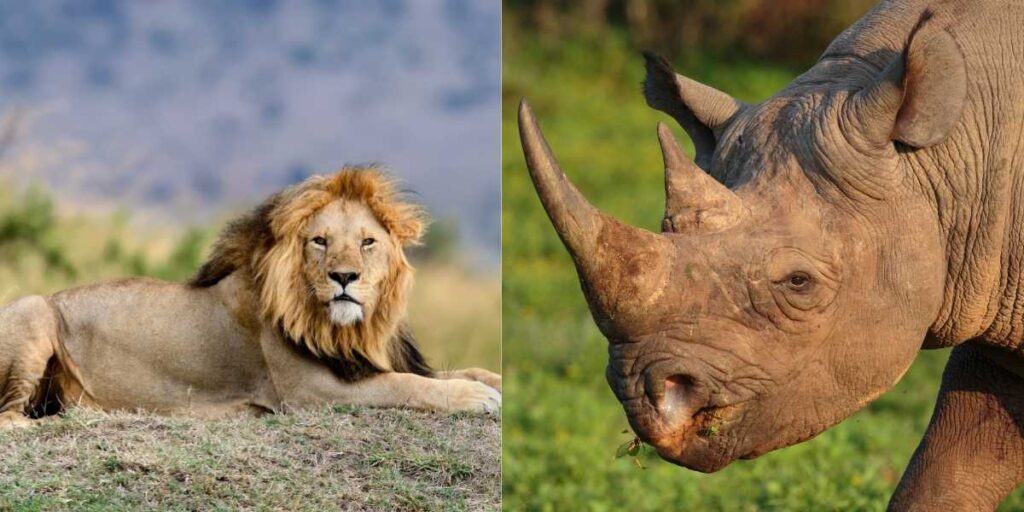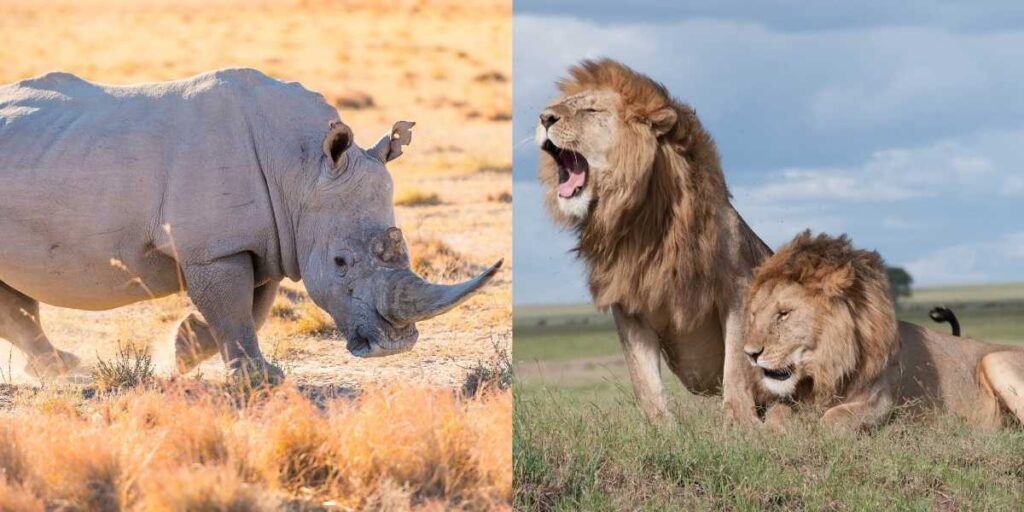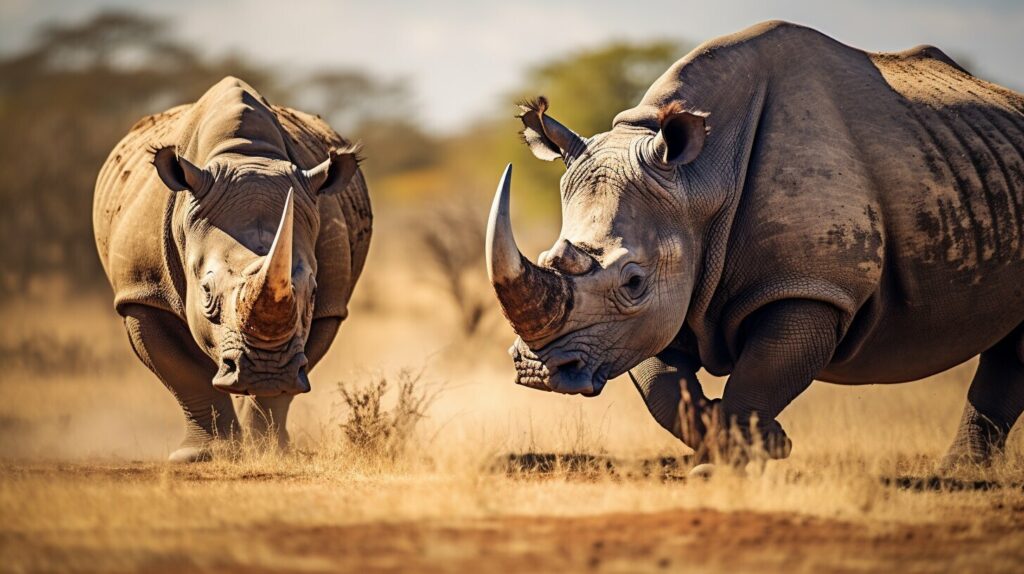In the vast plains of the African savannah, two apex predators, the indomitable rhinoceros, and the majestic lion, lock horns in a fierce battle for dominance. Join us as we venture into the heart of this primal struggle, exploring the unique strengths and strategies each creature employs. The Rhino vs Lion saga promises an adrenaline-fueled journey through the wild, shedding light on the relentless competition between these formidable forces of nature.
Key Takeaways:
- Rhinos are massive creatures, weighing up to 3,000 pounds, while lions rely on their agility and hunting skills.
- Lions typically target medium-sized prey, while rhinos are rarely targeted due to their size and defensive armor.
- Rhinos inhabit grasslands and savannas, whereas lions prefer open grassy plains and woodlands.
- Both rhinos and lions face threats from poaching, habitat loss, and diseases, making conservation efforts crucial.
- The hypothetical battle between a rhino and a lion raises questions about their respective strengths and strategies.
As we delve deeper into the world of rhinos and lions, we will explore their size, strength, habitat, hunting techniques, and the challenges they face in the fight for survival. Join me on this wild adventure as we unravel the mysteries of the animal kingdom’s epic showdown.

Rhino vs Lion: Size and Strength
Understanding the size and strength of rhinos and lions is crucial in analyzing their potential confrontations. Rhinos are known for their massive build, with adult males weighing up to 3,000 pounds. Their impressive size is complemented by their thick armor-like skin, which serves as a defense against the sharp claws and teeth of predators. On the other hand, lions are agile hunters, typically weighing between 300 to 500 pounds for males and around 250 pounds for females. Their muscular bodies and sharp teeth make them formidable predators in the animal kingdom.
When it comes to physical strength, both rhinos and lions possess unique abilities. Rhinos possess immense power in their charge, capable of reaching speeds of up to 30 miles per hour. Their strong horn can be a deadly weapon, allowing them to fend off potential threats. Lions, on the other hand, have powerful jaws and sharp claws, enabling them to take down their prey efficiently. Their muscular bodies provide them with the agility and strength required for successful hunts.
In a hypothetical confrontation between a rhino and a lion, the outcome would largely depend on various factors such as the size and age of the rhino, as well as the number and experience of the lions involved. While a pride of lions may attempt to bring down a rhino, it is rare for them to succeed due to the rhino’s robust physique and defensive capabilities. Both rhinos and lions are formidable creatures in their own right, each showcasing unique size and strength attributes that contribute to their survival in the animal kingdom.
Size Comparison:
| Rhino | Lion |
|---|---|
| Weight: Up to 3,000 pounds | Male: 300-500 pounds Female: Around 250 pounds |
| Size: Up to 6 feet tall and 11-13 feet long | Male: Up to 4 feet tall (shoulder height) and 6-9 feet long Female: Slightly smaller in size |
Rhino vs. Lion: Habitat and Behavior
The distinct habitats and behaviors of rhinos and lions play a significant role in their interactions with one another. Rhinos are well-adapted to live in grasslands, savannas, and dense vegetation areas, where they can find ample vegetation to graze on. Their size and impressive strength make them less vulnerable to predation, and they often have a solitary lifestyle, except for a mother and her calf. Rhinos are known for their territorial behavior and will mark their territory using urine and feces as a way to defend their space.
Lions, on the other hand, prefer open grassy plains and woodlands, where they can take advantage of their exceptional agility and speed during hunts. They are highly social animals, living in pride that consists of multiple adult females, their cubs, and a few adult males. The females take on the responsibility of hunting, often working together to bring down their prey. Lions communicate through vocalizations, such as roars and growls, which help to establish dominance and maintain group cohesion.

The Impact of Habitat on Interactions
The differing habitats and behaviors of rhinos and lions shape their interactions. Due to their preferred habitats, encounters between the two species in the wild are relatively rare. Rhinos, with their strong territorial behavior, tend to keep their distance from lions by remaining in dense vegetation areas or avoiding open grasslands where the lions thrive. This reduces the opportunity for direct confrontations between the two.
However, when their territories overlap, there may be instances where lions attempt to prey on rhinos, particularly the smaller black rhino. These encounters usually involve the lions trying to outsmart the rhino by circling it, hoping to catch it off guard and expose its vulnerable back. Despite their hunting prowess, lions have a difficult time bringing down such a massive and well-protected creature. While the battles between rhinos and lions are rare, they are indeed epic and captivating in the animal kingdom.
To gain a better understanding of the contrasting behaviors and habitats of rhinos and lions, let’s take a look at the table below:
| Rhinos | Lions |
|---|---|
| Habitat | Grasslands, savannas, dense vegetation areas |
| Behavior | Solitary (except for mother and calf), territorial |
| Prey | Vegetation |
| Communication | Loud vocalizations (roars, growls) |
| Habitat | Open grassy plains, woodlands |
| Behavior | Social (live in prides), cooperative hunting |
| Prey | Carnivorous (antelope, zebra, buffalo) |
| Communication | Loud vocalizations (roars, growls) |
The contrasting habitat preferences and behavioral patterns of rhinos and lions make their interactions fascinating to observe. While they may occasionally cross paths, these encounters are infrequent due to their distinct territories and preferred habitats. Understanding the dynamics between these two powerful creatures adds to the awe-inspiring complexity of the animal kingdom.
Exploring the prey preferences and hunting tactics of rhinos and lions sheds light on their unique survival methods. Rhinos, with their massive size and sturdy armor, are primarily herbivores, feeding on a variety of grasses, leaves, and branches. They are perfectly adapted to their herbivorous lifestyle, with their specialized lips and teeth allowing them to grasp and tear vegetation. Rhinos are grazers, spending hours each day grazing and browsing for food, and their large size enables them to consume vast quantities of plant matter. While they may seem docile and peaceful when feeding, rhinos can become incredibly aggressive and dangerous if provoked or threatened.
On the other hand, lions are apex predators and rely on their hunting skills to survive. They are incredibly opportunistic and adaptable hunters, capable of taking down a wide range of prey. Lions are known for their cooperative hunting behavior, with the lionesses working together to bring down larger prey. They utilize stealth, speed, and strength to overpower their victims, often cooperating through strategic planning and communication. Lions are ambush predators, patiently stalking their prey until the perfect opportunity arises to strike. Once a suitable target is identified, the lionesses launch a coordinated attack, utilizing their sharp claws and powerful jaws to immobilize and ultimately bring down their prey.

In terms of prey preference, lions typically target medium-sized ungulates such as antelope, zebra, and buffalo. These animals provide them with a substantial source of food and fulfill the nutritional needs of the pride. While it is uncommon for lions to attack rhinos due to their formidable size and defensive capabilities, there have been instances where lions have successfully brought down a rhino, particularly when the rhino is vulnerable or injured. Such confrontations between rhinos and lions are rare but highlight the fierce competition for resources in the animal kingdom.
To summarize, rhinos and lions have distinct prey preferences and hunting strategies. Rhinos rely on their herbivorous diet and sheer size as a means of survival, while lions harness their predatory instincts and cooperative hunting tactics to secure their next meal. Understanding these strategies deepens our appreciation for the intricate balance of power and survival in the animal kingdom.
In summary, the battle between a rhino and a lion is a clash of strength and strategy. While the rhino relies on its massive size and armored exterior, the lion utilizes its speed, agility, and hunting instincts. These opposing tactics make it challenging to predict an outcome in a hypothetical face-off between these two mighty creatures.
| Rhino | Lion |
|---|---|
| Massive size and weight | Speed and agility |
| Thick skin as armor | Sharp claws and teeth |
| Powerful horn as a weapon | Teamwork and coordination |
“When a rhino and a lion cross paths, their respective strategies and tactics determine the outcome of their encounter.”
The battle between a rhino and a lion is a fascinating showdown in the animal kingdom. While each animal possesses unique strengths and tactics, the result of such an encounter remains uncertain. Both creatures play vital roles in their respective ecosystems and face significant conservation challenges due to factors such as poaching and habitat loss. Preserving these majestic species is crucial to maintaining the delicate balance of the natural world.
Challenges to Rhino and Lion Conservation
The conservation efforts for rhinos and lions are crucial due to the numerous challenges they face. Both species are currently listed as vulnerable on the IUCN Red List, with some subspecies even facing the threat of extinction. Rhinos are particularly vulnerable to poaching for their horns, which are highly valued in traditional medicine and illegal wildlife trade. The demand for lion parts, such as bones, teeth, and skins, also contributes to the illegal wildlife market. These relentless poaching activities have led to a significant decline in both rhino and lion populations.
Habitat loss is another significant challenge facing rhinos and lions. The expansion of human settlements, agriculture, and infrastructure development encroaches upon their natural territories, fragmenting habitats and reducing available resources. As their habitats shrink, rhinos and lions face increased competition for limited food and water sources, leading to conflicts and potential population decline. Additionally, habitat loss disrupts natural migration patterns and breeding cycles, further impacting the long-term survival of these majestic creatures.
Diseases also pose a threat to the conservation of rhinos and lions. Rapid urbanization and human encroachment into wildlife habitats increase the risk of diseases spreading between humans and animals. Rhinos are susceptible to various diseases, including tuberculosis and foot-and-mouth disease, which can devastate their populations. Lions, on the other hand, are vulnerable to infectious diseases, such as feline immunodeficiency virus (FIV) and feline leukemia virus (FeLV). The transmission of these diseases can have cascading effects on the overall ecological balance and jeopardize the survival of these iconic species.
Poaching and habitat loss have had a devastating impact on the populations of rhinos and lions. According to recent statistics, the number of both black and white rhinos has drastically declined over the years due to poaching, with only a few thousand individuals remaining in the wild. Similarly, lion populations have experienced a significant decline, with their numbers estimated to be less than 20,000 in the wild, down from hundreds of thousands a century ago.
The loss of these magnificent creatures not only affects the biodiversity of their respective habitats but also has broader ecological implications. Rhinos play a vital role in shaping their ecosystems as seed dispersers and grazers, helping maintain the balance of plant species and promoting healthy vegetation growth. Lions, as apex predators, regulate the populations of herbivores, preventing overgrazing and promoting overall ecosystem stability.
Conservation efforts aimed at combating poaching, securing protected areas, and promoting sustainable land-use practices are essential for the survival of rhinos and lions. Strict law enforcement, community involvement, and international cooperation are vital in curbing the illegal wildlife trade and preserving these iconic species for future generations. By addressing the challenges of poaching, habitat loss, and diseases, we can ensure the long-term survival of these majestic creatures and protect the intricate web of life they are a part of.
The Impact of Poaching and Habitat Loss
Poaching and habitat loss pose significant threats to the survival of both rhinos and lions, impacting their populations. Despite efforts to conserve these majestic animals, illegal hunting for their valuable horns and the destruction of their natural habitats continue to jeopardize their existence.
The illegal trade in rhino horns is driven by the misguided belief in their medicinal properties, leading to a high demand in certain Asian markets. Poachers relentlessly target rhinos, often resorting to violent methods to obtain their horns. This ruthless pursuit has decimated rhino populations, pushing some species to the brink of extinction. According to recent studies, the black rhino population has declined by a staggering 98% since the 1960s.
Lions, too, suffer from the devastating effects of poaching and habitat loss. Commercial hunting for trophies and body parts threatens their survival, while the encroachment of human settlements into their natural habitats restricts their range and access to prey. As their habitats shrink, lion populations become fragmented, making them more vulnerable to inbreeding and genetic decline.
Conservation efforts aim to combat these threats by implementing rigorous anti-poaching measures and establishing protected areas where these animals can thrive. Organizations and governments work tirelessly to raise awareness, enforce laws, and rehabilitate injured or displaced animals. However, the battle against poaching and habitat loss remains an ongoing struggle that requires global collaboration and sustained commitment.
The loss of suitable habitats due to human activities, such as agriculture, infrastructure development, and urbanization, further exacerbates the challenges faced by rhinos and lions. As natural landscapes are transformed or destroyed, these animals are forced to compete for limited resources within smaller and more isolated areas.
This habitat loss and fragmentation disrupts the delicate balance of ecosystems, leading to a cascade of negative effects. It reduces available prey for lions, forcing them to venture closer to human settlements in search of food. For rhinos, habitat loss restricts their access to feeding grounds and water sources, making it difficult for them to sustain their populations.
Additionally, fragmentation hinders the ability of these animals to migrate and disperse, limiting their genetic diversity and increasing the risk of inbreeding. This genetic bottleneck weakens their resilience to diseases and environmental changes, making them more susceptible to extinction.
| Threat | Impact on Rhinos | Impact on Lions |
|---|---|---|
| Poaching | Drastic decline in populations due to illegal hunting for horns. | Loss of individuals through trophy hunting and illegal trade. |
| Habitat Loss | Restricted access to feeding grounds and water sources. | Increased proximity to human settlements and limited prey availability. |
| Fragmentation | Genetic decline and higher vulnerability to diseases. | Disruption of migration patterns and reduced genetic diversity. |
Conclusion
In conclusion, the clash between a rhino and a lion is a captivating scenario, but predicting the outcome of such a battle remains a subject of speculation. It is important to remember that both animals possess unique strengths and strategies that make them highly adapted to their respective environments.
FAQ
Q: Are rhinos bigger than lions?
Yes, rhinos are generally much larger than lions. Rhinos are among the largest terrestrial mammals, with an average weight ranging from 1,000 to 2,300 kilograms (2,200 to 5,000 pounds) or more, depending on the species. In contrast, lions are much smaller, with adult males weighing between 190 to 225 kilograms (420 to 500 pounds) on average. The significant size difference reflects the distinct ecological roles and adaptations of these two species within their respective ecosystems.
Q: Why are lions scared of rhinos?
Lions are not inherently scared of rhinos, but they typically avoid confrontations with these formidable herbivores due to the potential danger involved. Rhinos, particularly species like the white rhinoceros, are large, powerful, and equipped with formidable horns, making them a formidable presence in the animal kingdom. Lions, being predators, may choose not to engage with rhinos to avoid the risk of injury from a rhino’s powerful defense mechanisms. Animals in the wild often exhibit behaviors that minimize unnecessary risks, and avoiding potential conflicts with rhinos is a survival strategy for lions.
Q: Who is stronger rhino or lion?
In the intriguing matchup between a rhino and a lion, the rhino emerges as the epitome of strength. Its massive size, formidable horn, and robust build paint a portrait of dominance in the wild. While lions showcase agility and hunting prowess, the raw power embodied by the rhino tips the scales in its favor.
Q: What is the likelihood of a pride of lions successfully taking down a rhino?
A: It is rare for a pride of lions to successfully take down a rhino, especially the black rhino which is the smallest African species. The lions usually try to circle the rhino in the hope that it exposes its back, which is their only chance of success. However, the rhino’s thick armor is tough enough to repel the lions’ sharp claws.
Q: Where do rhinos and lions typically live?
A: Rhinos can be found in grasslands, savannas, and dense vegetation areas, while lions prefer open grassy plains and woodlands.
Q: What do lions hunt and what are their hunting strategies?
A: Lions are carnivores and typically target medium-sized prey such as antelope, zebra, and buffalo. They hunt in groups, with the females doing most of the hunting. While they may occasionally take down larger prey, such as rhinos, it is not their primary focus.
Q: What are the major threats faced by rhinos and lions?
A: Both rhinos and lions face threats from poaching, habitat loss, and diseases. These challenges make conservation efforts for these species particularly challenging.


